|
CHAPTER V.
The Common Frog | ||
5. CHAPTER V.
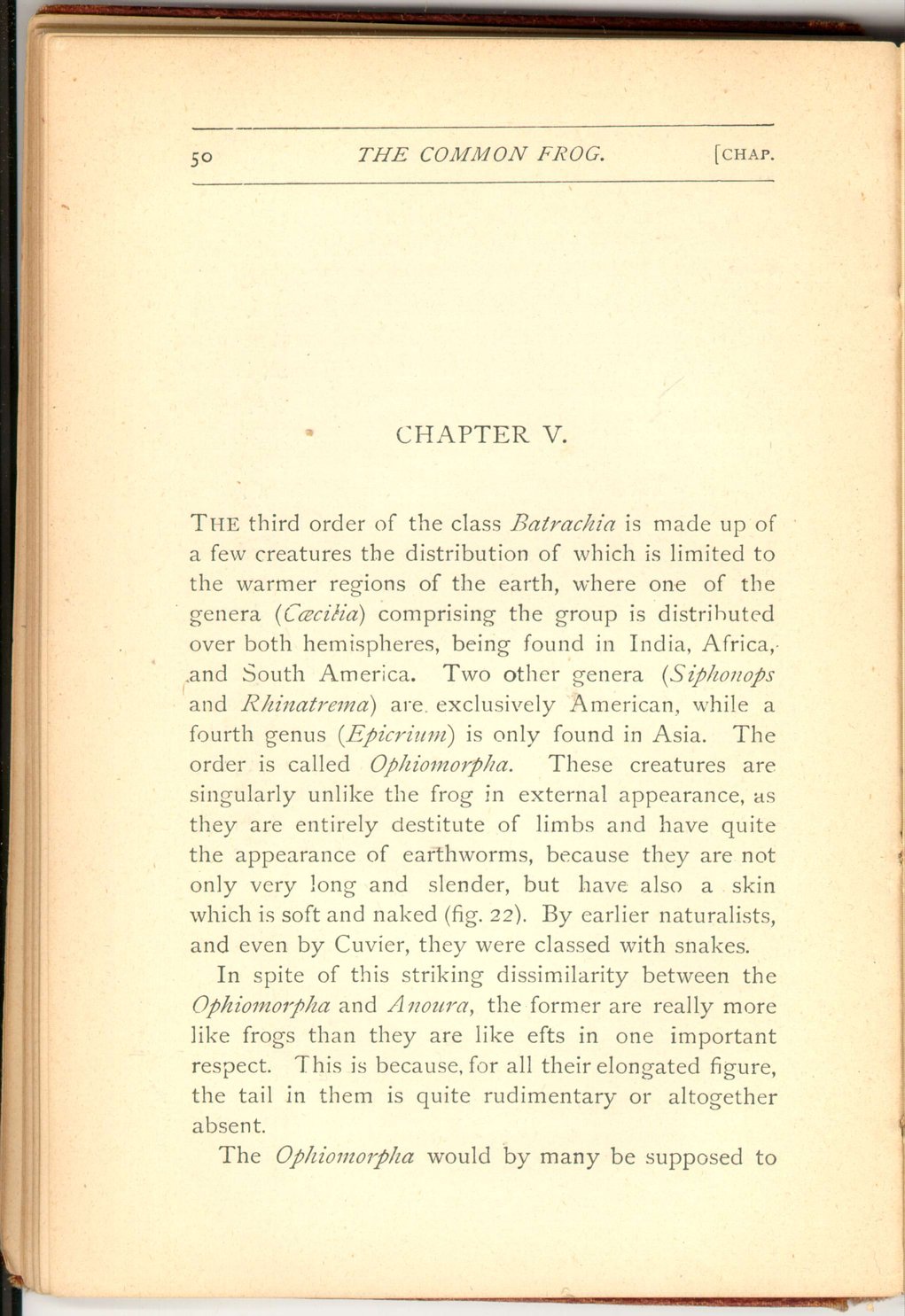 [Description:
Image of page 50.
]
[Description:
Image of page 50.
]
The third order of the class Batrachia is made up of a
few creatures the distribution of which is limited to the
warmer regions of the earth, where one of the genera
(Cœcilia)
comprising the group is distributed over both hemispheres,
being found in India, Africa, and South America. Two other
genera (Siphonops
and Rhinatrema) are
exclusively American, while a fourth genus (
Epicrium) is only found in Asia. The order
is called Ophiomorpha.
These creatures are singularly unlike the frog in external
appearance, as they are entirely destitute of limbs and
have quite the appearance of earthworms, because they are
not only very long and slender, but have also a skin
which is soft and naked (fig. 22). By earlier naturalists,
and even by Cuvier, they were classed with snakes.
In spite of this striking dissimilarity between the Ophiomorpha and Anoura, the former are really more like frogs than they are like efts in one important respect. This is because, for all their elongated figure, the tail in them is quite rudimentary or altogether absent.
The Ophiomorpha would by many be supposed to
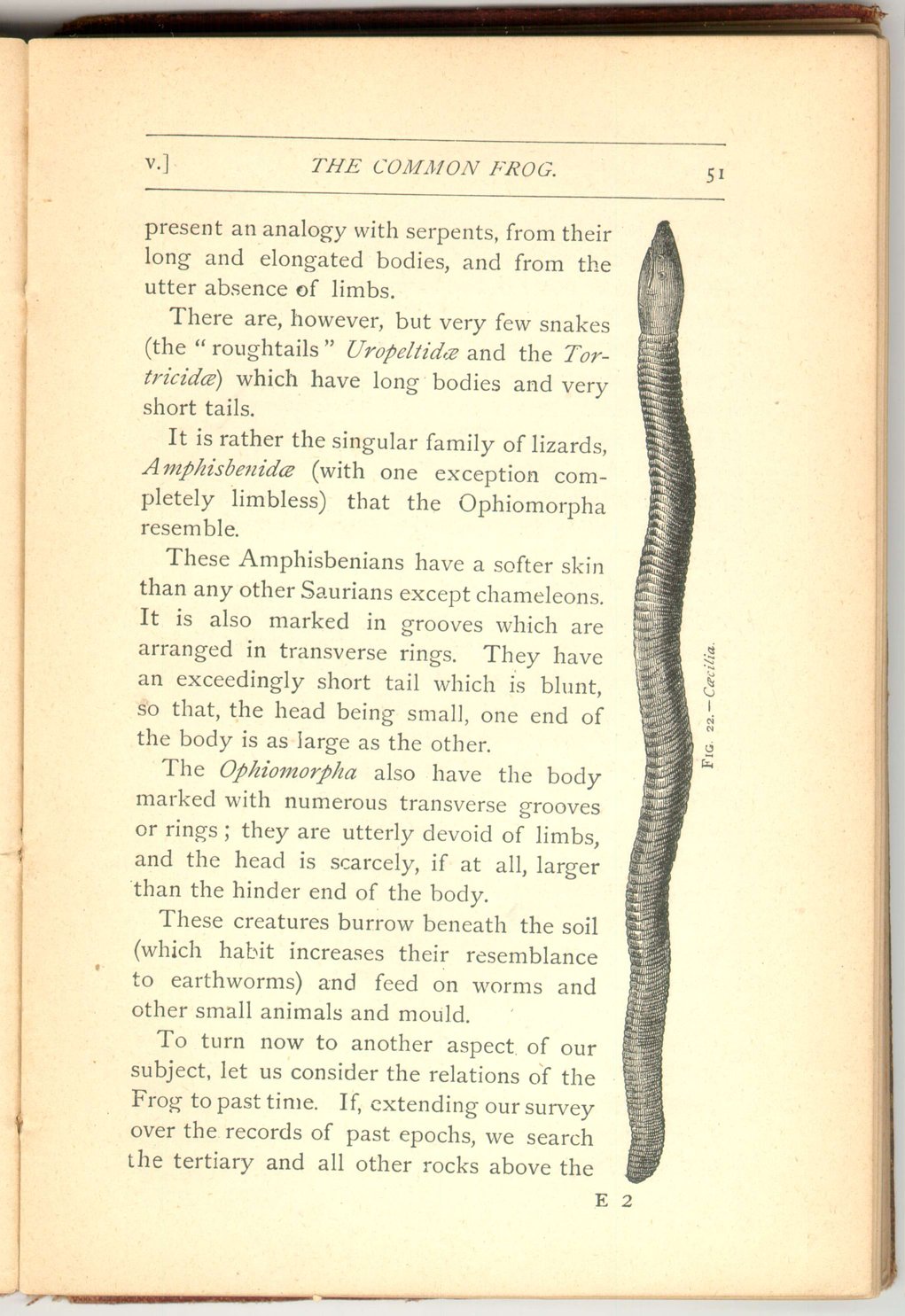 [Description:
Image of page 51.
]
[Description:
Image of page 51.
]
There are, however, but very few snakes (the "roughtails" Uropeltidæ and the Tortricidæ) which have long bodies and very short tails.
It is rather the singular family of lizards, Amphisbenidæ (with one exception completely limbless) that the Ophiomorpha resemble.
These Amphisbenians have a softer skin than any other Saurians except chameleons. It is also marked in grooves which are arranged in transverse rings. They have an exceedingly short tail which is blunt, so that, the head being small, one end of the body is as large as the other.
The Ophiomorpha also have the body marked with numerous transverse grooves or rings; they are utterly devoid of limbs, and the head is scarcely, if at all, larger than the hinder end of the body.
These creatures burrow beneath the soil (which habit increases their resemblance to earthworms) and feed on worms and other small animals and mould.
To turn now to another aspect of our subject, let us consider the relations of the Frog to past time. If, extending our survey over the records of past epochs, we search the tertiary and all other rocks above the
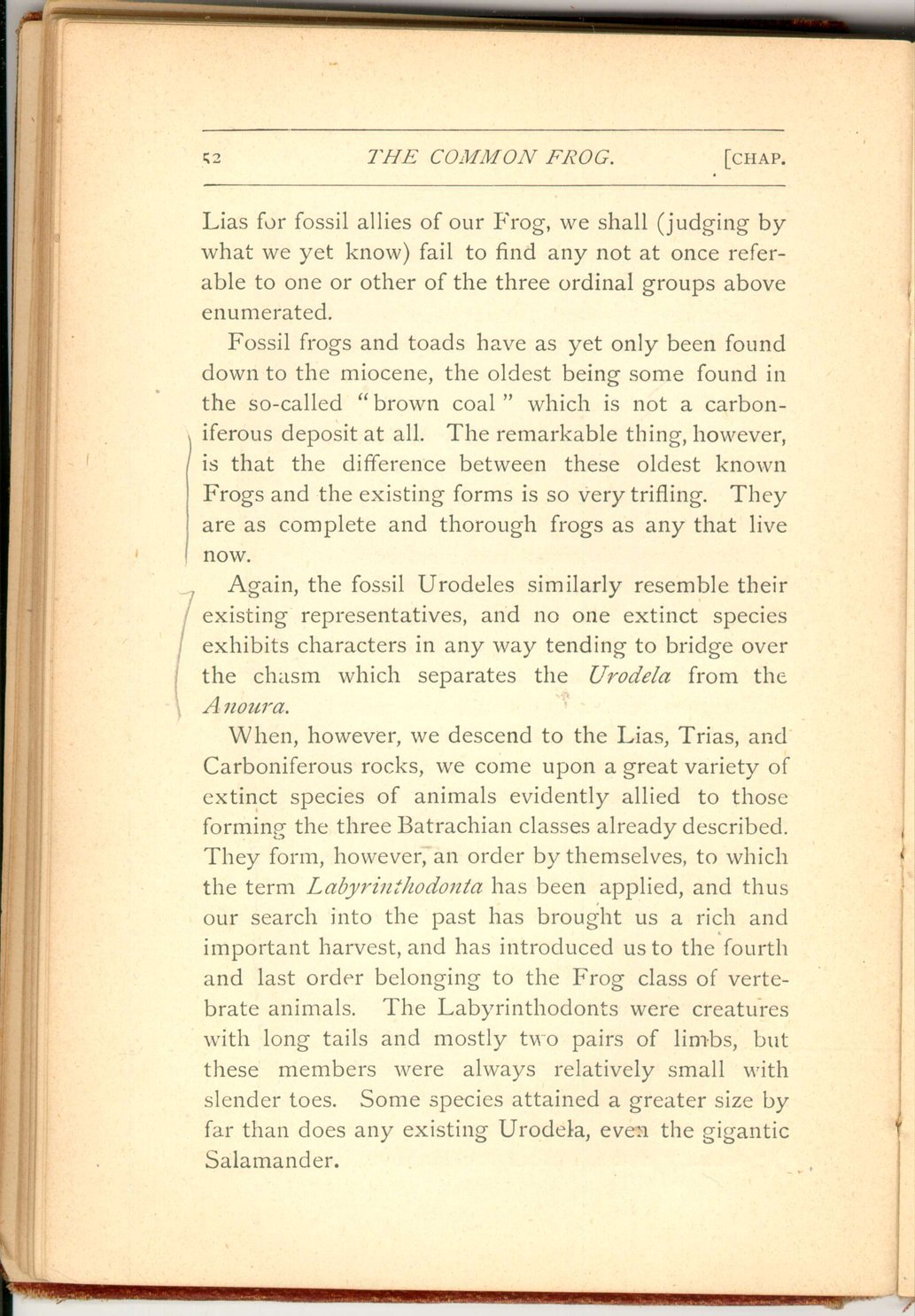 [Description:
Image of page 52.
]
[Description:
Image of page 52.
]
Fossil frogs and toads have as yet only been found down to the miocene, the oldest being some found in the so-called "brown coal" which is not a carboniferous deposit at all. The remarkable thing, however, is that the difference between these oldest known Frogs and the existing forms is so very trifling. They are as complete and thorough frogs as any that live now.
Again, the fossil Urodeles similarly resemble their existing representatives, and no one extinct species exhibits characters in any way tending to bridge over the chasm which separates the Urodela from the Anoura.
When, however, we descend to the Lias, Trias, and Carboniferous rocks, we come upon a great variety of extinct species of animals evidently allied to those forming the three Batrachian classes already described. They form, however, an order by themselves, to which the term Labyrinthodonta has been applied, and thus our search into the past has brought us a rich and important harvest, and has introduced us to the fourth and last order belonging to the Frog class of vertebrate animals. The Labyrinthodonts were creatures with long tails and mostly two pairs of limbs, but these members were always relatively small with slender toes. Some species attained a greater size by far than does any existing Urodela, even the gigantic Salamander.
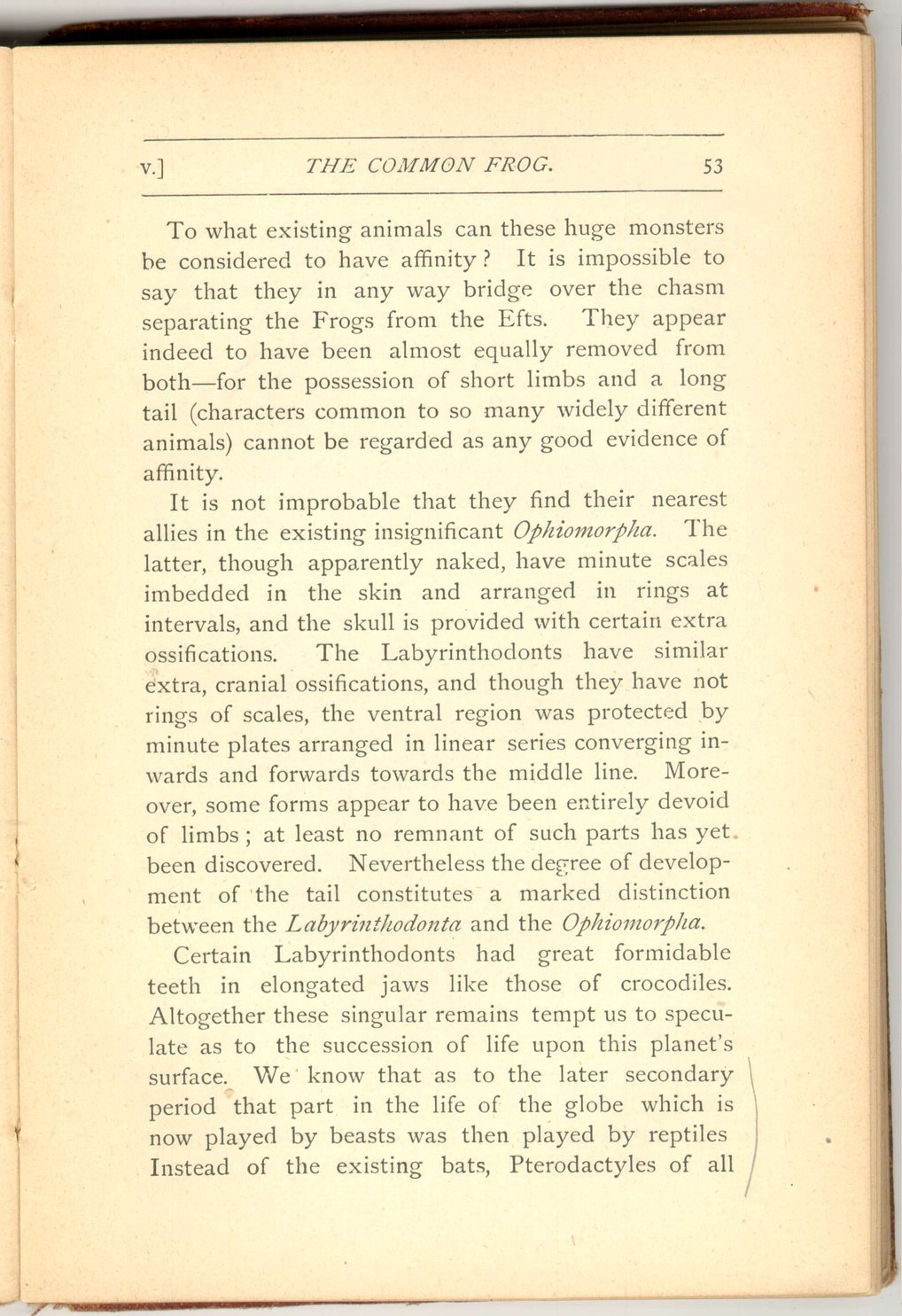 [Description:
Image of page 53.
]
[Description:
Image of page 53.
]
To what existing animals can these huge monsters be considered to have affinity? It is impossible to say that they in any way bridge over the chasm separating the Frogs from the Efts. They appear indeed to have been almost equally removed from both—for the possession of short limbs and a long tail (characters common to so many widely different animals) cannot be regarded as any good evidence of affinity.
It is not improbable that they find their nearest allies in the existing insignificant Ophiomorpha. The latter, though apparently naked, have minute scales imbedded in the skin and arranged in rings at intervals, and the skull is provided with certain extra ossifications. The Labyrinthodonts have similar extra, cranial ossifications, and though they have not rings of scales, the ventral region was protected by minute plates arranged in linear series converging inwards and forwards towards the middle line. Moreover, some forms appear to have been entirely devoid of limbs; at least no remnant of such parts has yet been discovered. Nevertheless the degree of development of the tail constitutes a marked distinction between the Labyrinthodonta and the Ophiomorpha.
Certain Labyrinthodonts had great formidable teeth in elongated jaws like those of crocodiles. Altogether these singular remains tempt us to speculate as to the succession of life upon this planet's surface. We know that as to the later secondary period that part in the life of the globe which is now played by beasts was then played by reptiles Instead of the existing bats, Pterodactyles of all
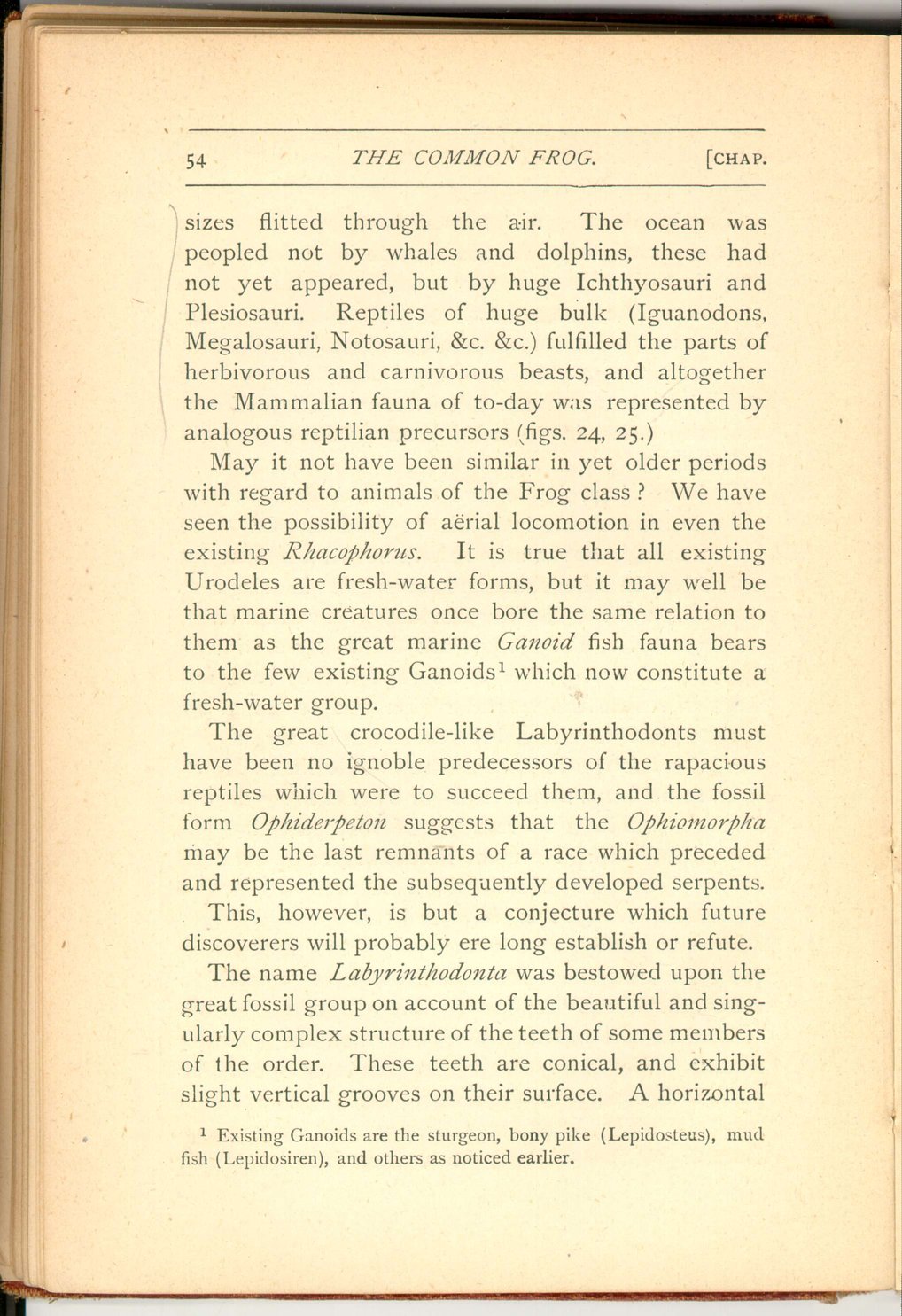 [Description:
Image of page 54.
]
[Description:
Image of page 54.
]
May it not have been similar in yet older periods with regard to animals of the Frog class? We have seen the possibility of aërial locomotion in even the existing Rhacophorus. It is true that all existing Urodeles are fresh-water forms, but it may well be that marine creatures once bore the same relation to them as the great marine Ganoid fish fauna bears to the few existing Ganoids [13] which now constitute a fresh-water group.
The great crocodile-like Labyrinthodonts must have been no ignoble predecessors of the rapacious reptiles which were to succeed them, and the fossil form Ophiderpeton suggests that the Ophiomorpha may be the last remnants of a race which preceded and represented the subsequently developed serpents.
This, however, is but a conjecture which future discoverers will probably ere long establish or refute.
The name Labyrinthodonta was bestowed upon the great fossil group on account of the beautiful and singularly complex structure of the teeth of some members of the order. These teeth are conical, and exhibit slight vertical grooves on their surface. A horizontal
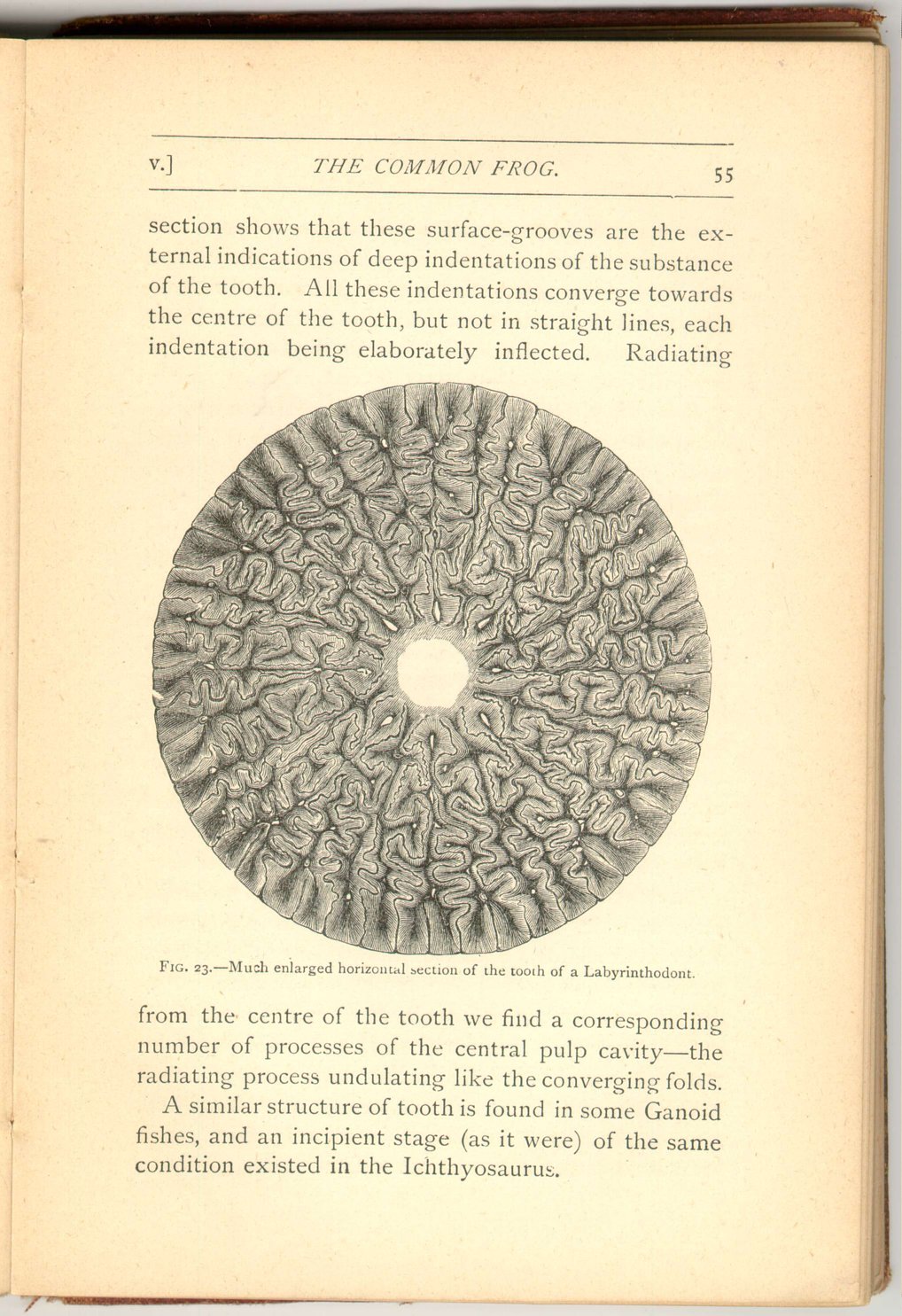 [Description:
Image of page 55.
]
[Description:
Image of page 55.
]
A similar structure of tooth is found in some Ganoid fishes, and an incipient stage (as it were) of the same condition existed in the Ichthyosaurus.
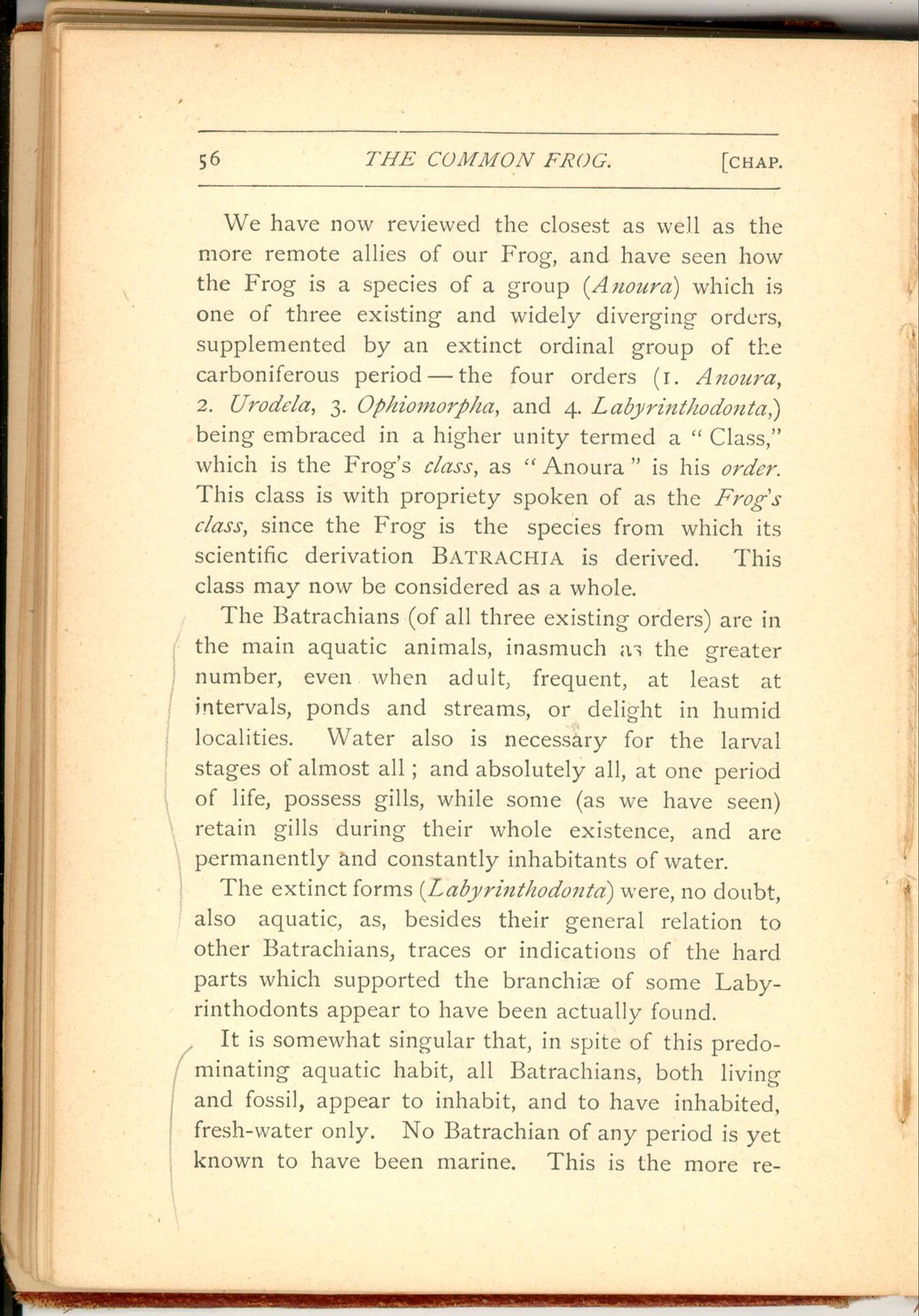 [Description:
Image of page 56.
]
[Description:
Image of page 56.
]
The Batrachians (of all three existing orders) are in the main aquatic animals, inasmuch as the greater number, even when adult, frequent, at least at intervals, ponds and streams, or delight in humid localities. Water also is necessary for the larval stages of almost all; and absolutely all, at one period of life, possess gills, while some (as we have seen) retain gills during their whole existence, and are permanently and constantly inhabitants of water.
The extinct forms (Labyrinthodonta) were, no doubt, also aquatic, as, besides their general relation to other Batrachians, traces or indications of the hard parts which supported the branchiæ of some Labyrinthodonts appear to have been actually found.
It is somewhat singular that, in spite of this predominating aquatic habit, all Batrachians, both living and fossil, appear to inhabit, and to have inhabited, fresh-water only. No Batrachian of any period is yet known to have been marine. This is the more
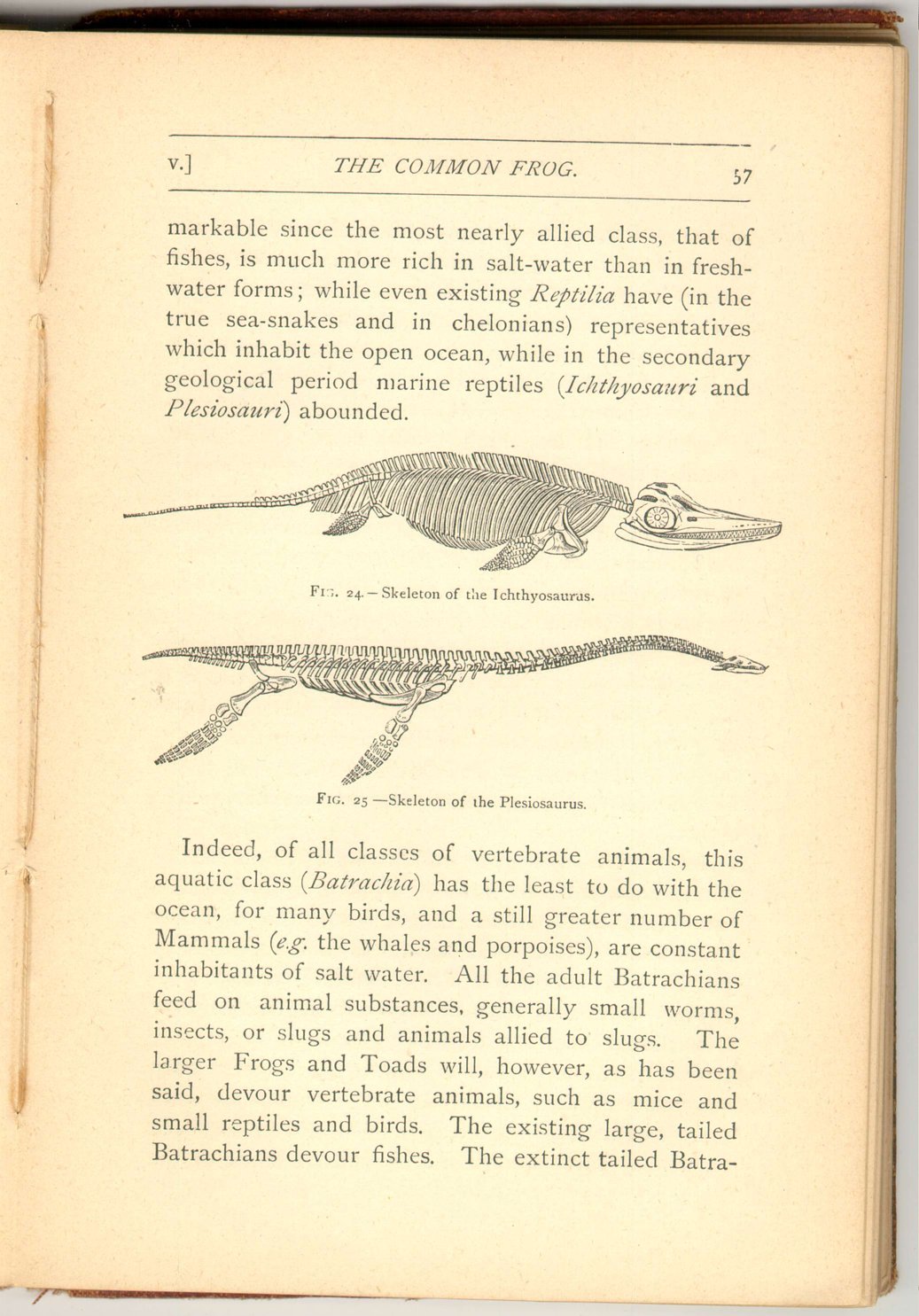 [Description:
Image of page 57.
]
[Description:
Image of page 57.
]
Indeed, of all classes of vertebrate animals, this aquatic class (Batrachia) has the least to do with the ocean, for many birds, and a still greater number of Mammals (e.g. the whales and porpoises), are constant inhabitants of salt water. All the adult Batrachians feed on animal substances, generally small worms, insects, or slugs and animals allied to slugs. The larger Frogs and Toads will, however, as has been said, devour vertebrate animals, such as mice and small reptiles and birds. The existing large, tailed Batrachians devour fishes. The extinct tailed
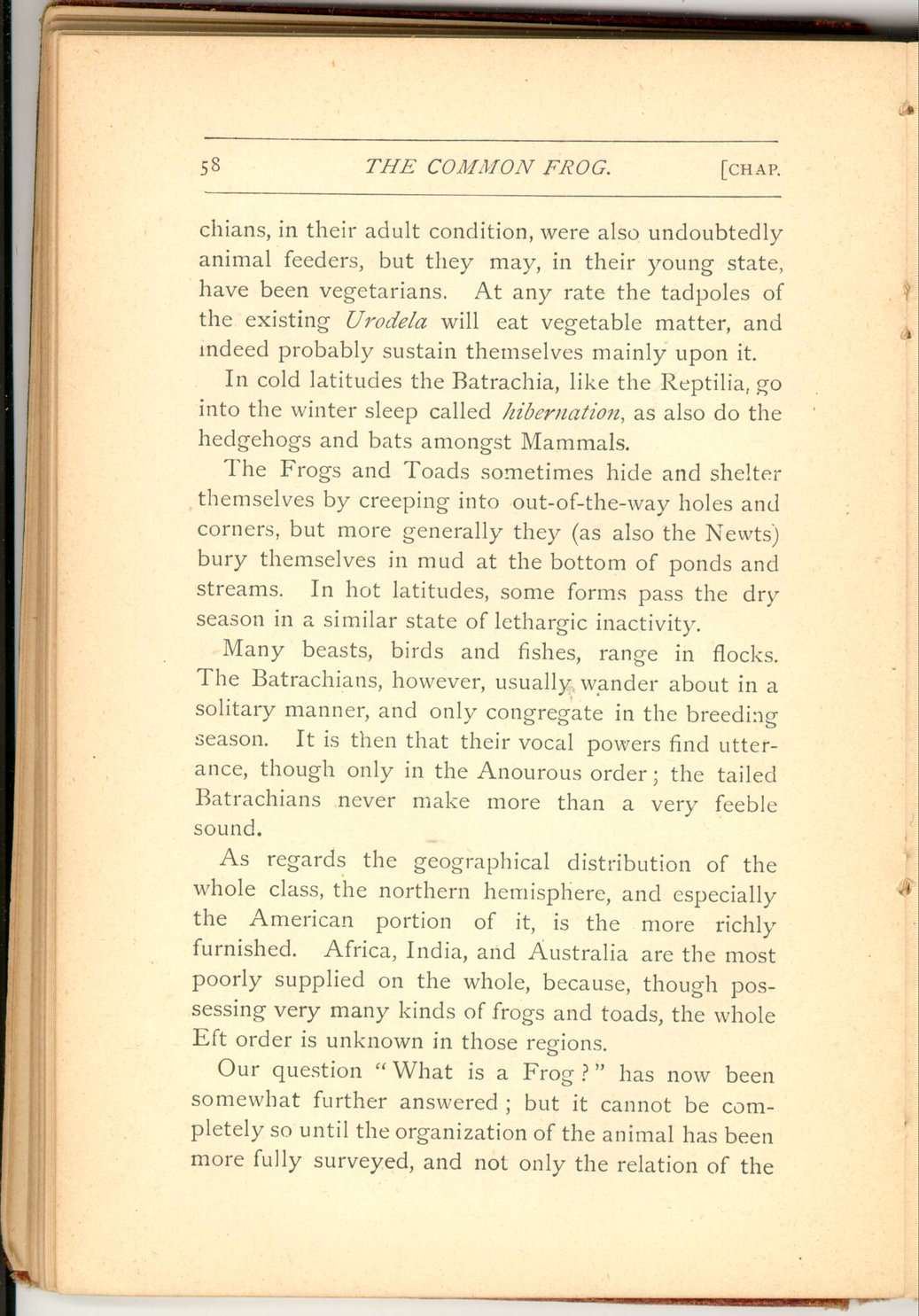 [Description:
Image of page 58.
]
[Description:
Image of page 58.
]
In cold latitudes the Batrachia, like the Reptilia, go into the winter sleep called hibernation, as also do the hedgehogs and bats amongst Mammals.
The Frogs and Toads sometimes hide and shelter themselves by creeping into out-of-the-way holes and corners, but more generally they (as also the Newts) bury themselves in mud at the bottom of ponds and streams. In hot latitudes, some forms pass the dry season in a similar state of lethargic inactivity.
Many beasts, birds and fishes, range in flocks. The Batrachians, however, usually wander about in a solitary manner, and only congregate in the breeding season. It is then that their vocal powers find utterance, though only in the Anourous order; the tailed Batrachians never make more than a very feeble sound.
As regards the geographical distribution of the whole class, the northern hemisphere, and especially the American portion of it, is the more richly furnished. Africa, India, and Australia are the most poorly supplied on the whole, because, though possessing very many kinds of frogs and toads, the whole Eft order is unknown in those regions.
Our question "What is a Frog?" has now been somewhat further answered; but it cannot be completely so until the organization of the animal has been more fully surveyed, and not only the relation of the
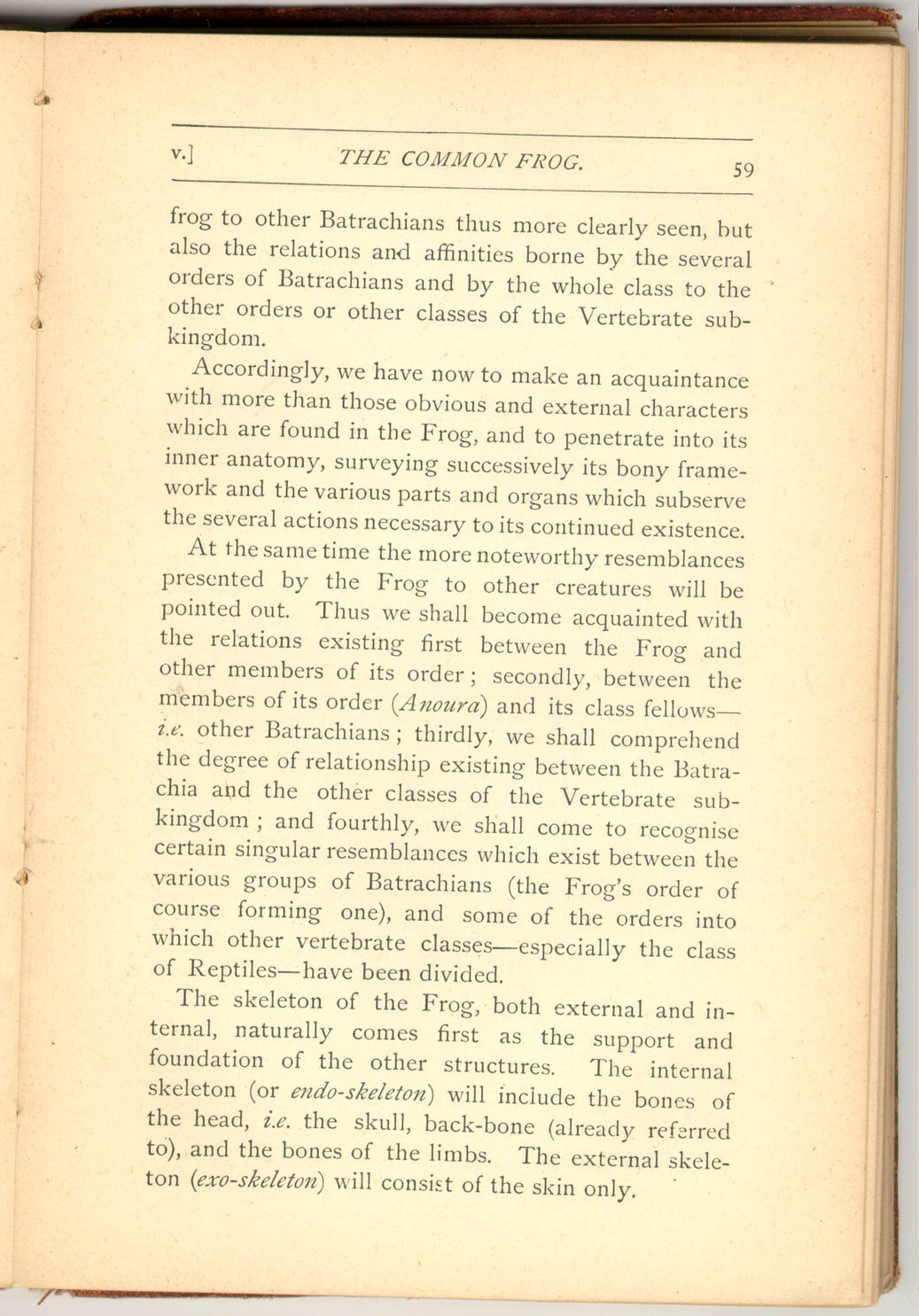 [Description:
Image of page 59.
]
[Description:
Image of page 59.
]
Accordingly, we have now to make an acquaintance with more than those obvious and external characters which are found in the Frog, and to penetrate into its inner anatomy, surveying successively its bony framework and the various parts and organs which subserve the several actions necessary to its continued existence.
At the same time the more noteworthy resemblances presented by the Frog to other creatures will be pointed out. Thus we shall become acquainted with the relations existing first between the Frog and other members of its order; secondly, between the members of its order (Anoura) and its class fellows—i.e. other Batrachians; thirdly, we shall comprehend the degree of relationship existing between the Batrachia and the other classes of the Vertebrate sub-kingdom; and fourthly, we shall come to recognise certain singular resemblances which exist between the various groups of Batrachians (the Frog's order of course forming one), and some of the orders into which other vertebrate classes—especially the class of Reptiles—have been divided.
The skeleton of the Frog, both external and internal, naturally comes first as the support and foundation of the other structures. The internal skeleton (or endo-skeleton) will include the bones of the head, i.e. the skull, back-bone (already referred to), and the bones of the limbs. The external skeleton (exo-skeleton) will consist of the skin only.
FOOTNOTES: Chapter 5
|
CHAPTER V.
The Common Frog | ||